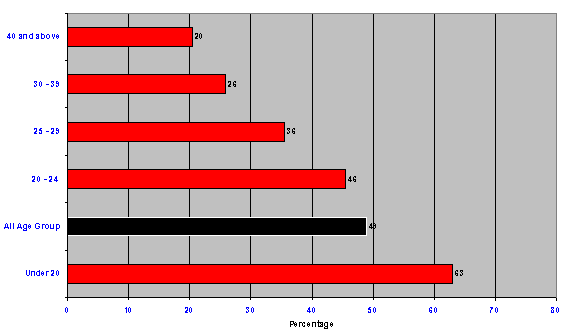Re-imprisonment rates by age at first imprisonment
In general, offenders who commence their offending careers during their teenage years are considerably more likely to become persistent offenders, particularly if their initial crimes are ones that result in a prison sentence. At any given point in time only a modest proportion of the prison population in New Zealand is aged under 20 years. Many prisoners generally however were first convicted and imprisoned when they were young.
The graph below indicates that for the 2002/03 prison release cohort, about half of the prisoners were first imprisoned under the age of 20. About 75 percent of prisoners were first imprisoned at the age of 24 or under. Only five percent of prisoners were first imprisoned at the age of 40 or more.
This is even more pronounced for Maori prisoners, 57 percent of whom were first imprisoned at the age of 19 or under. Further, around 80 percent of Maori prisoners were first imprisoned at the age of 24 or under, while just two percent were first imprisoned at the age of 40 or older.
Graph 3: Distribution of age at first imprisonment

The link between early onset and later persistence is even more pronounced when the figures for convictions and community sentences is examined. The figure below indicates that, of the 2002/03 prison release cohort, about 68 percent were first convicted (though not necessarily imprisoned) at the age of 19 or under. About 85 percent of offenders were first convicted at the age of 24 or under. Amongst Maori prisoners, 76 percent were first convicted before age 20, and 91 percent first convicted by age 24 or under.
Graph 4: Distribution of age at first conviction

As the graph below indicates, prisoners first imprisoned by age 19 are 3.2 times more likely to be reconvicted and re-imprisoned than are those whose very first imprisonment occurred when they were over the age of 40.
Graph 5: Re-imprisonment rate by age at first imprisonment


